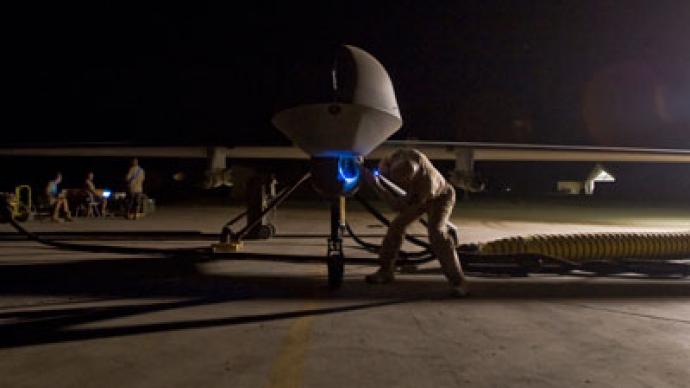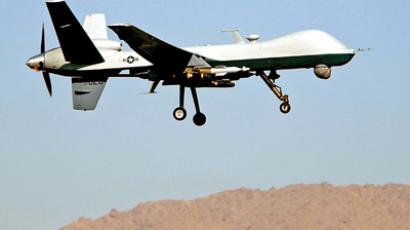Pentagon secretly flying drones in US airspace

Thousands of pages detailing plans for the domestic use of unmanned aerial vehicles (UAVs), or drones, have been released by the Electronic Frontier Foundation.
The San Francisco, California-based EFF published a trove of military and police files on Wednesday that they obtained through Freedom of Information Act requests for documents pertaining to drone programs across the United States.“These records, received as a result of EFF’s Freedom of Information Act lawsuit against the Federal Aviation Administration (FAA), come from state and local law enforcement agencies, universities and — for the first time — three branches of the US military: the Air Force, Marine Corps, and DARPA (Defense Advanced Research Projects Agency),” explains the EFF.Although drones are deployed regularly overseas for both surveillance purposes and in hunting enemy combatants, the use of UAVs within the US has been a topic that has been rarely acknowledged, let alone discussed, by agencies across the country. And while even the EFF is still making sense of the vast collection of drone documents they’ve obtained through their FOIA suit, a preliminary analysis offers a good insight into just how serious some agencies are about putting drones in American airspace. “While the US military doesn’t need an FAA license to fly drones over its own military bases (these are considered “restricted airspace”), it does need a license to fly in the national airspace (which is almost everywhere else in the US),” the EFF’s Jennifer Lynch explains on the organization’s website. “And, as we’ve learned from these records, the Air Force and Marine Corps regularly fly both large and small drones in the national airspace all around the country.”“This is problematic,” Lynch writes, “given a recent New York Times report that the Air Force’s drone operators sometimes practice surveillance missions by tracking civilian cars along the highway adjacent to the base.”The article in question, published earlier this year on July 6, highlight’s Times’ reporter Mark Mazzetti’s recent field trip to the Holloman Air Force base in New Mexico, where he witnessed from a remote command post with other members of the media the live video stream of a surveillance drone flew overhead.“A white S.U.V. traveling along a highway adjacent to the base came into the cross hairs in the center of the screen and was tracked as it headed south along the desert road. When the S.U.V. drove out of the picture, the drone began following another car,” Mazzetti recalled.His article continues:“’Wait, you guys practice tracking enemies by using civilian cars?’ a reporter asked. One Air Force officer responded that this was only a training mission, and then the group was quickly hustled out of the room.”The military’s relative silence when it comes to drone use is mirrored in the public sector, perhaps most recently in the case of the San Diego, California’s Sheriff’s Department. As RT reported last month, law enforcement there has been unwilling to cooperate with FOIA requests for information on a proposed drone program, despite evidence of inquiries into obtaining an UAV available on the public record. On the Sheriff’s Department’s part, they argue that "there is very little public benefit in the release of such records" and cite that reason in their refusal to cooperate with requests submitted by the MuckRock.com website.In Lynch’s write-up describing the papers received by the EFF, she explains, “Once again, we see in these records that law enforcement agencies want to use drones to support a whole host of police work.” In addition to uncovering information about both the Air Force and Marine Corps’ separate drone programs, Lynch notes that the FOIA request reveals much about efforts to conduct aerial surveillance by the Queen Anne County, Maryland Sheriff’s Department outside of Baltimore.In one file from the Sheriff’s Office, it describes cooperation planned with the US Department of Justice, Department of Homeland Security and the Navy in putting a Wasp II drone in the sky for an array of surveillance matters, including spying on suspicious persons:“The WASP II will be used for survelliance [sic throughout] missions in close proximity to the operator.For example, search Farm fields for marijuana (the operator would be stationed on the farm and would use the WASP to see the crop growth from the air), conducting search and rescue in remote areas (QA's county has a state park.Searching the river and coves can be difficult because of the high grasses. An aerial view would be of significant help), survelliance of people of interest (watching open drug market transactions before initiating an arrest), providing aerial observation of houses when serving warrants.All of these missions are currently not be adequately served and the opearation of a WASP would provide low cost assistance.”Similar plans are discussed by the Gadsden, Alabama Police Department, Montgomery County, Texas law enforcement and other agencies across the country in the FOIA documents now available on EFF.org.














